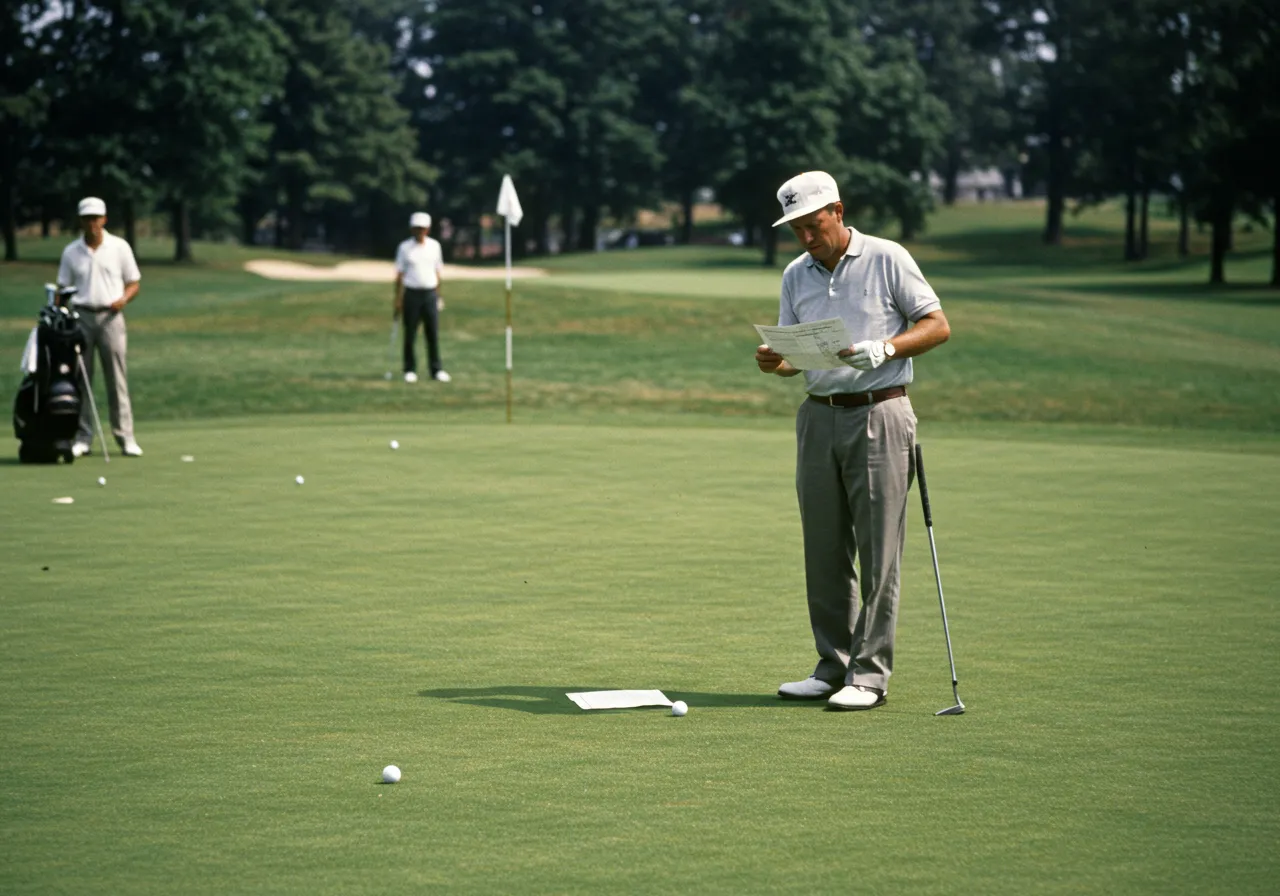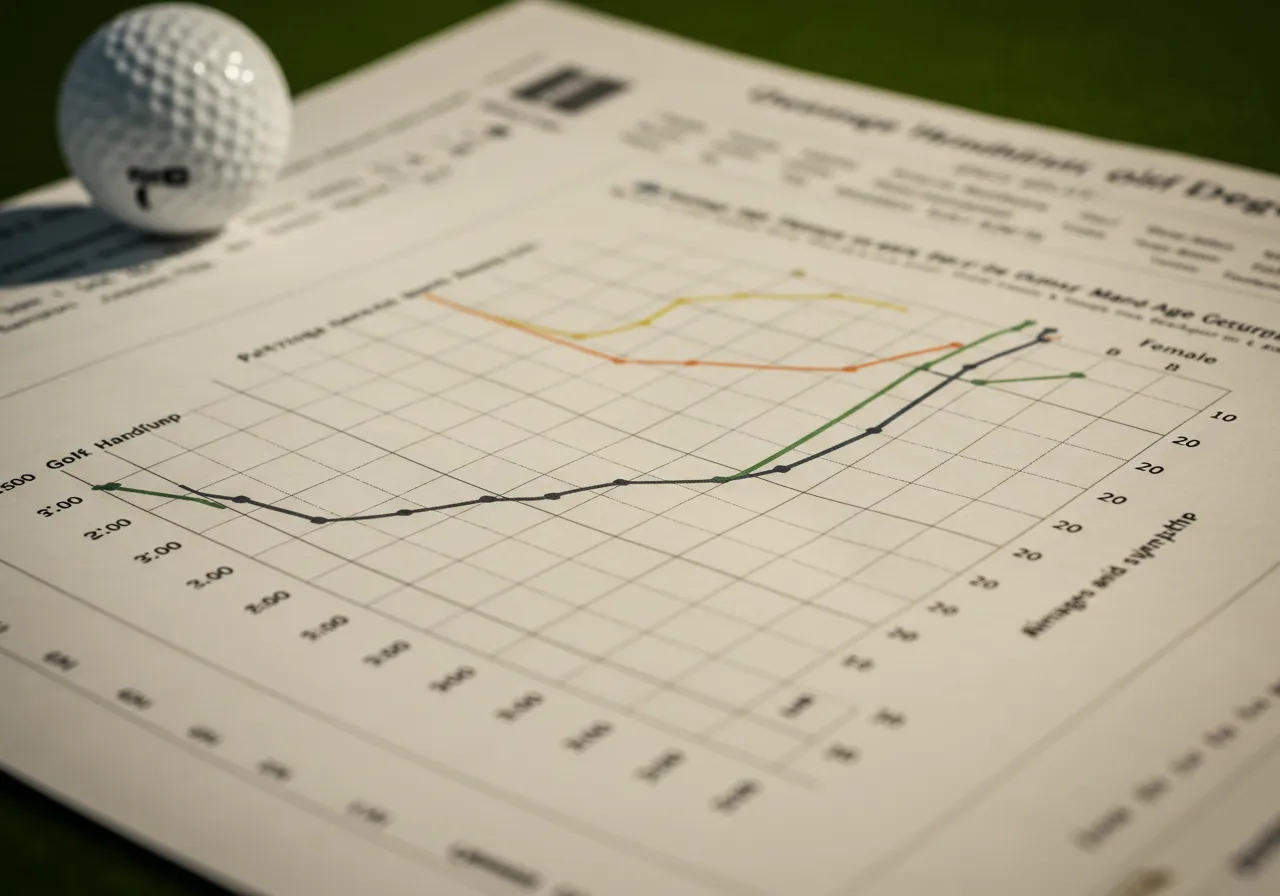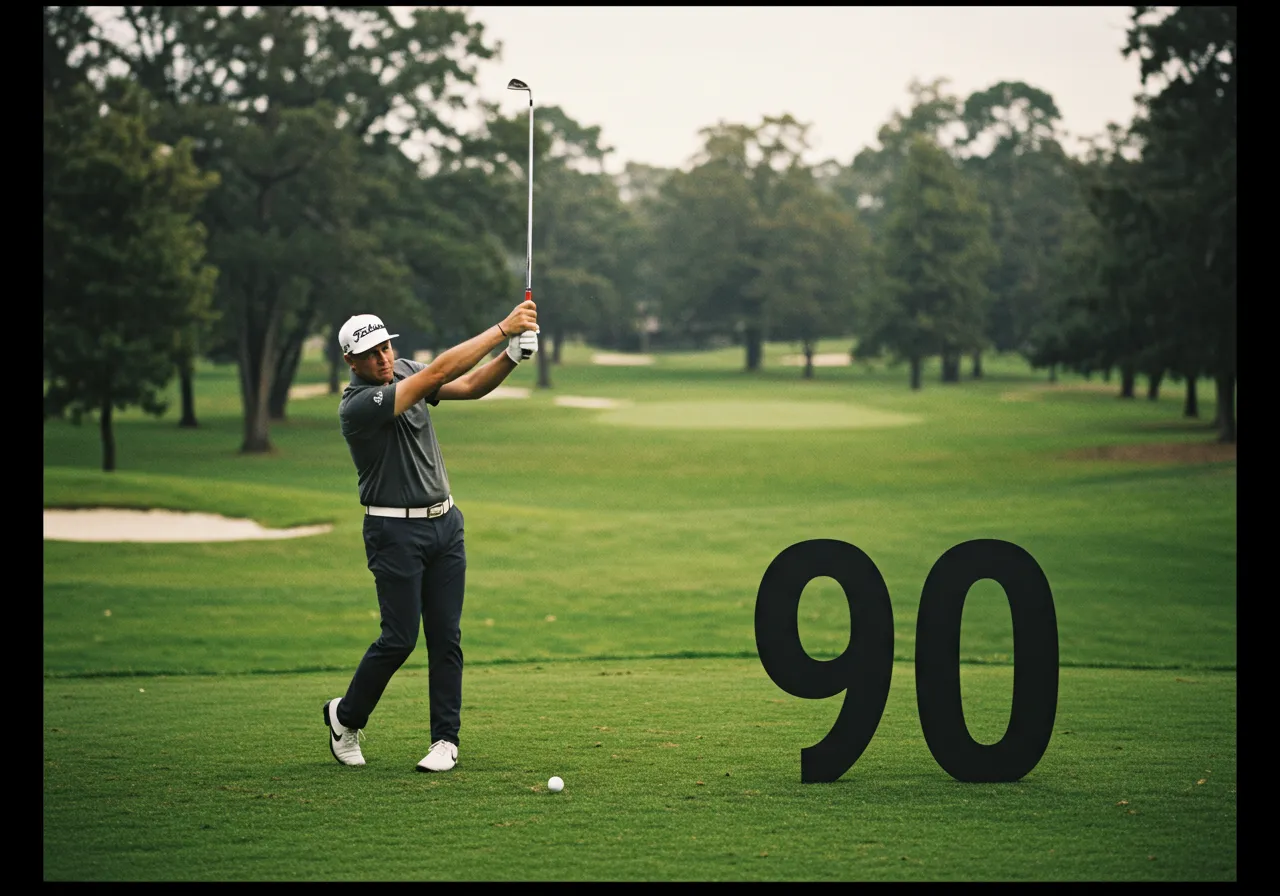What Percent of Golfers Break 90 and Why It Matters
We Are Talking About What Percent of Golfers Break 90? Only about 26 out of 100 golfers do it, says the National Golf Foundation. That means breaking 90 is a big achievement in golf. On average, men score around 97 and women around 114, so getting under 90 is tough.
Most golfers who break 90 have a handicap under 18. The secret? Play smart, not risky. Aim for bogeys, not birdies. And practice your chipping and putting. That’s where you can save the most strokes and get better fast.
Golfers who break 90 often dedicate time to honing their skills and learning course management. While this goal is challenging, it is attainable with consistent effort and proper training.
For many, the percentage of golfers that break 90 represents not just a number but a testament to their dedication and love for the sport.
What Percentage of Golfers Break 90
A study by the National Golf Foundation says that only about 26 out of 100 golfers can score under 90 often. That makes it a special goal for many players.
The table below shows how most golfers usually score.
| Score Range | What It Means | About How Many Golfers |
|---|---|---|
| Under 90 | Very good! Mid-handicap or better | About 26 out of 100 |
| 90 to 99 | Average golfers | About 29 out of 100 |
| 100 to 109 | New or less experienced players | About 25 out of 100 |
| 110 and above | Beginners or struggling golfers | About 20 out of 100 |
Is Breaking 90 In Golf A Big Thing For Beginners
Breaking 90 in golf is a significant milestone for many amateur golfers. It signifies a level of skill and consistency. For many, it marks the transition from beginner to intermediate player. Understanding the importance of this benchmark can motivate golfers to improve their game.
The Significance Of The 90 Score Of Golfer Break
Scoring under 90 on a par 72 course means averaging bogey or better. This is impressive for an amateur. It shows mastery of basic techniques. It also indicates good course management skills. For many, breaking 90 is a long-term goal. Achieving it brings immense satisfaction and pride.
Comparing Amateur Vs. Professional Benchmarks Of Golf Score
While amateurs aim to break 90, professionals have different standards. Pros typically aim to score in the 60s or low 70s. The table below highlights the key differences:
| Category | Amateurs | Professionals |
|---|---|---|
| Average Score | 90+ | 69-72 |
| Scoring Goals | Break 90 | Break 70 |
| Key Skills | Basic techniques, course management | Advanced techniques, precision |
Amateurs breaking 90 shows growth and improvement. Professionals aim for excellence and consistency. Both benchmarks represent important milestones in a golfer’s journey.
What Score Do Average Golfers Get In The Golf Play
Understanding golfers’ performance can provide insights into the game. Analyzing golfers’ scores helps us see the percentage of golfers breaking 90. This analysis uses different sources to ensure accurate data.
Sources Of Golf Scoring Data
To analyze golfers’ scores, we need reliable data sources. Below are some key sources:
- Golf Associations: Data from organizations like the USGA.
- Golf Course Records: Scores recorded at various golf courses.
- Online Golf Platforms: Websites where golfers log their scores.
- Surveys and Studies: Research conducted by golf magazines and websites.
These sources provide a comprehensive look at golfers’ performance. Using multiple sources ensures the data is robust and accurate.
How Many Golfers Break 90 In the World
Most of the data about golf scores comes from the United States, so it may not show the full picture around the world.
In many countries, golf is less common, and there are more casual or beginner golfers. That means the number of players who break 90 worldwide is likely lower than in the U.S., where about 26% do.
The ability to break 90 depends on skill, how often someone plays, and how easy it is to access good practice facilities.
The table below gives an idea of how different types of golfers score and whether they usually break 90.
| Type of Golfer | Skill Level | Typical Score Range | Breaks 90 Often? |
|---|---|---|---|
| Professional golfers | Expert | 70–72 | Yes |
| Low-handicap amateurs | Advanced | 75–85 | Yes |
| Mid-handicap amateurs | Average | 85–95 | Sometimes |
| High-handicap golfers | Developing | 95–110 | Rarely |
| Casual or beginner golfers | New to the game | 110–130+ | Very rarely |
This breakdown helps show that most golfers around the world do not break 90, especially those who are new to the sport or play only occasionally. Regular practice, good coaching, and consistent play make a big difference.
What Is The Average Golf Handicap By Age And Gender
Golf scores can be different depending on your age, gender, and handicap level. On average, men score around 97, and women score around 114. A golfer’s handicap helps explain how skilled they are.
For example, if your handicap is lower than 18, you’re more likely to break 90 regularly. Younger golfers may score better because they often have more strength and flexibility, while older golfers may play smarter through experience. These differences help us understand who is likely to score lower and why.
This table shows average golf scores by age group, gender, and handicap level.
| Category | Average Score | Breaks 90 Often? | Notes |
|---|---|---|---|
| Male golfers (all ages) | ~97 | Sometimes | Mid-handicap varies with practice |
| Female golfers (all ages) | ~114 | Rarely | The higher average is due to swing speed, access |
| Handicap < 18 | 85 or lower | Often | Skilled, more consistent golfers |
| Handicap 18–28 | 95–105 | Occasionally | Still learning, improving players |
| Handicap 28+ | 110+ | Rarely | High-handicap or beginner-level |
| Golfers under the age of 30 | 90–95 | Sometimes | May have more physical strength |
| Golfers age 30–50 | 95–100 | Sometimes | A mix of skill and experience |
| Golfers age 50+ | 100–110 | Rarely | Rely more on accuracy and course strategy |
Note: This shows that golf performance changes by age, gender, and skill level. Understanding these numbers can help you set better goals and track your own progress more clearly.
Demystifying The 90-barrier: How Many Golfers Actually Make It
Breaking 90 in golf is a significant milestone. Many golfers dream of achieving it. But what percent of golfers truly break 90? Let’s dive into the numbers and factors behind this elusive goal.
Overall Percentages Of Golfer Breaking 90: A Global Perspective
Globally, only a small fraction of golfers break 90. According to various studies, less than 25% of golfers consistently score below 90. This statistic highlights the challenge many face in the sport.
| Handicap Range | Percentage of Golfers |
|---|---|
| Below 10 | 10% |
| 10-19 | 20% |
| 20 and above | 70% |
The table above shows the distribution of golfers based on their handicap. A lower handicap often correlates with breaking 90, but only a minority consistently achieve this.
Factors Affecting The Ability To Break 90 In Golf
Various factors influence a golfer’s ability to break 90. Understanding these can provide insights into improving performance.
- Practice and Training: Regular practice is crucial. Golfers who practice often have a better chance of breaking 90.
- Course Difficulty: The course’s difficulty level can impact scores. More accessible courses might see more golfers breaking 90.
- Equipment: Using the right equipment can make a difference. Proper clubs and balls tailored to a golfer’s style can improve performance.
- Mental Game: Golf is as much mental as it is physical. Staying focused and calm under pressure is essential.
These factors play a significant role in a golfer’s journey. Each element can either help or hinder the quest to break 90.
Impact Of Experience And Training On Golf Scoring
Breaking 90 in golf is a major milestone for many players. Experience and training greatly influence a golfer’s ability to achieve this goal.
Understanding how years of play and structured practice impact scores can help golfers enhance their performance.
What Percentage Of Golfers Break 90 Consistently
The number of years a golfer has played significantly affects their scoring potential. Here’s a breakdown of how experience correlates with breaking 90:
| Years of Play | Likelihood of Breaking 90 |
|---|---|
| 1-2 years | 10% |
| 3-5 years | 25% |
| 6-10 years | 50% |
| 10+ years | 70% |
Golfers with more years of play tend to score better. Experience helps in understanding course management and shot execution. Consistency improves with years of play, making breaking 90 more achievable.
Effect Of Coaching And Practice Routines To Improve Golf Score
Coaching and structured practice routines play a crucial role in improving scores. Here are some key factors:
- Professional Coaching: Guidance from a coach provides personalized feedback and accelerates improvement.
- Regular Practice: Consistent practice helps master swing mechanics and short-game skills.
- Focused Drills: Specific drills target weaknesses and enhance overall performance.
- Mental Training: Coaches often help with mental strategies, which are crucial for consistent scoring.
Implementing a structured practice routine increases the chances of breaking 90. Regular feedback and focused drills can significantly enhance a golfer’s skills.
- Schedule regular practice sessions.
- Work with a professional coach.
- Focus on specific areas of improvement.
- Track progress and adjust routines as needed.
By combining experience with effective training, golfers can steadily improve their scores.
Equipment And Technology: Do They Help Golfers Break 90
Golfers always seek ways to improve their scores. Equipment and technology play a significant role. But do they help golfers break 90?
Let’s dive into the impact of golf equipment and technology advancements on a golfer’s performance.
Advancements In Golf Equipment To Improve Golf Score
Golf equipment has come a long way. Modern clubs have better designs. They help players hit the ball farther and straighter. Here are some key advancements:
- Adjustable Drivers: These allow players to tweak loft and weight.
- Forgiving Irons: They reduce mishits and improve accuracy.
- High-Tech Balls: These offer more spin control and distance.
These tools can make a difference. They help average players improve their game.
The Role Of Technology In Improving Scores
Technology has revolutionized golf training. Golf simulators provide realistic practice environments. They help players analyze their swings and make adjustments. Below are some ways technology aids improvement:
- Launch Monitors: Trackball speed, launch angle, and spin rate.
- GPS Devices: Provide accurate distances to greens and hazards.
- Smartphone Apps: Offer swing analysis and score tracking.
With these tools, golfers get instant feedback. This helps them understand their weaknesses and work on them. Does equipment and technology help golfers break 90? The answer is yes. Proper use of advanced equipment and technology can lower scores.
What Are The Psychological Aspects Of Breaking 90 In Golf
Breaking 90 in golf is a significant achievement. For many, it’s not just about skill. The mind plays a crucial role, and understanding the psychological aspects can make a difference.
Common Myths About Breaking 90
Some people believe things about golf that just aren’t true. These are called myths. If you want to break 90, don’t let these ideas stop you.
You don’t need to be perfect, and you don’t need to hit the ball super far. What really helps is playing smart, being accurate, and practicing your short game.
Here are some common golf misconceptions and the truth about them:
Mental Barriers And Performance In Golf Scoring
Mental barriers often hinder performance. Players may feel pressure or anxiety. These feelings can affect swings and decisions. Overcoming these barriers is key.
- Fear of Failure: Worrying about making mistakes can cause tension.
- Lack of Confidence: Doubting abilities can lead to poor shots.
- Overthinking: Too many thoughts can disrupt focus.
Recognizing these barriers is the first step. Addressing them can improve performance.
The Most Challenging Aspects Of The Game For Sub-90 Golfers
Many golfers strive to break 90. This goal requires skill, practice, and an understanding of the game’s challenges. Let’s explore the most challenging aspects for golfers aiming to break 90.
Short Game Vs. Long Game Challenges In Golf
The short game includes putting, chipping, and pitching. Many golfers find this part difficult. Precision and touch are crucial here. The long game involves driving and long iron shots.
These shots demand power and accuracy. Both games have unique challenges.
| Aspect | Short Game | Long Game |
|---|---|---|
| Skills Needed | Precision, touch | Power, accuracy |
| Common Mistakes | Over-hitting, misjudging distance | Slicing, hooking |
Common Pitfalls On The Golf Course
Many golfers fall into common traps during a round. Here are some pitfalls:
- Overthinking: Too much analysis can hurt performance.
- Poor Course Management: Not planning shots can lead to trouble.
- Lack of Focus: Distractions can ruin concentration.
- Inconsistent Practice: Irregular practice affects skill development.
Avoiding these pitfalls can help golfers improve their scores and break 90.
Improvement Tips For Aspiring Sub-90 Golfers
Breaking 90 is a significant milestone for many golfers. It requires dedication, practice, and the proper techniques.
This section offers practical tips to help you achieve this goal.
Essential Skills To Focus On
To break 90 consistently, focus on improving these essential skills:
- Driving Accuracy: Keep the ball in play off the tee.
- Short Game: Master chipping and putting.
- Course Management: Plan your shots wisely.
- Mental Toughness: Stay calm under pressure.
Improving these skills can lower your scores significantly.
Training Aids And Drills That Make A Difference
Use training aids and drills to enhance your practice sessions:
| Training Aid | Purpose |
|---|---|
| Alignment Sticks | Improve aim and alignment. |
| Putting Mat | Practice putting indoors. |
| Chipping Net | Enhance your chipping accuracy. |
| Weighted Club | Build strength and flexibility. |
Here are some drills to incorporate:
- Lag Putting Drill: Focus on distance control with long putts.
- Up and Down Drill: Practice getting up and down around the green.
- Fairway Finder Drill: Hit 10 drives aiming to land in the fairway.
- Pressure Putt Drill: Sink 10 short putts in a row.
These aids and drills can make practice more effective and enjoyable.
Celebrating Milestones: Is Breaking 90 An Accomplishment
Breaking 90 in golf is a significant achievement. It marks a milestone in a golfer’s journey. This goal requires dedication, practice, and patience.
Many golfers dream of this achievement. It’s more than just a score; it’s a testament to hard work and progress.
Personal Stories Of Breaking 90 In Golf Scores
John’s story: John started golfing at age 40. He struggled with consistency and often scored above 100. He decided to take lessons and practice regularly.
After two years, John finally broke 90. He felt proud and accomplished.
Lisa’s journey: Lisa began golfing with her friends. She was determined to improve. She practiced every weekend and worked on her swing. After months of effort, Lisa broke 90. Her friends cheered and celebrated her success.
Setting And Achieving Golfing Goals
Setting goals is crucial for progress. Start with small, achievable targets. Gradually increase the difficulty. Here’s a simple goal-setting plan:
- Assess your current score: Know your average score.
- Identify areas for improvement: Focus on weak spots.
- Create a practice schedule: Dedicate time each week.
- Track your progress: Keep a record of your scores.
- Celebrate small wins: Recognize and reward yourself.
By following these steps, breaking 90 becomes more attainable. Stay committed and enjoy the journey.
Frequently Asked Questions
What Percentage Of People Break 90 In Golf?
About 26 percent of golfers that break 90 regularly. Achieving this score requires consistent practice and skill improvement.
What Percentage Of People Break 80 In Golf?
About 2% of golfers consistently break 80. Achieving this score requires significant skill and practice, and most golfers never reach this milestone.
How Many People Break 100 In Golf?
About 55 out of 100 golfers can score under 100 when they play a full round of golf. That means almost half of golfers still score 100 or more, especially if they are just starting out.
Breaking 100 is a big step for new golfers. It shows you are learning to control your shots and avoid big mistakes. The percentage of golfers that break 100, often practice more, plan their shots better, and get better at putting and chipping.
How Many Golfers Can Break 70?
Very few golfers can score under 70 in a full round of golf. In fact, less than 1 out of 100 golfers can do it. This is called breaking 70, and it means playing better than 2-under-par on most courses.
Only the best golfers, like professionals and top college players, can break 70. Even most really good players don’t do it often. To break 70, you need great skills in hitting the ball, putting, and making smart choices on the course.
What Percent Of Golfers Break 90?
About 26 out of every 100 golfers can score under 90 when they play 18 holes. This is based on research from the National Golf Foundation.
Golfers who break 90 usually have a handicap below 18, which means they are better than average. Most beginners and casual players score over 90, so breaking 90 shows good skill and practice.
It’s a big goal for many golfers and means you are doing better than most other players.
How Difficult Is It To Break 90?
Breaking 90 in golf is hard, but possible. Only about 26 out of 100 golfers can do it. That means most players score over 90.
To break 90, you need to hit the ball well, avoid big mistakes, and be good at putting and chipping. Most golfers who do this have a handicap under 18, which means they play at a good level.
You don’t need to be perfect or hit super far. You just need to play smart and practice often. For many golfers, breaking 90 is a big goal and shows you’re really improving.
What Score Is Needed To Break 90?
To break 90 in golf, you need to score 89 or less when playing 18 holes. Most golf courses have a total score called par 72. That means you can be up to 17 strokes over par and still break 90.
You don’t need to make lots of great shots. If you can make mostly bogeys (1 over par on each hole) and avoid big mistakes, you can do it. Many golfers reach this goal by being careful, smart, and practicing their putting and chipping.
How Many Golfers Break 90 Regularly?
Only about 26 out of every 100 golfers score under 90 when they play 18 holes. That means most golfers still score 90 or more.
Golfers who break 90 often have a handicap below 18, which means they are better than average. They don’t need to be perfect, but they are good at playing smart, avoiding big mistakes, and using strong putting and chipping skills.
Is Breaking 90 A Good Golf Score?
Yes, breaking 90 is a very good golf score for most people. Only about 26 out of 100 golfers can score under 90, so it means you are better than most amateur golfers.
If you can break 90, you likely have a handicap under 18, which shows you have good control, can play smart, and know how to avoid big mistakes. You also need to be strong in your short game, like putting and chipping.
What Is The Average Golf Score?
The average golf score for most players is about 97 for men and 114 for women when playing 18 holes. This information comes from the National Golf Foundation.
Most people who play golf are amateur or beginner golfers, and many have a handicap between 15 and 30. That means they are still learning and may not score very low yet.
What percentage of golfers break 100?
About 55 to 60 out of every 100 golfers can score under 100 for 18 holes. This means more than half of golfers reach this level, usually after some practice and learning the basics.
Conclusion
Breaking 90 is a significant milestone for many golfers. Only a small percentage achieve this feat. With dedication and practice, improving your golf game is possible. Focus on honing your skills, and you might join the ranks of those who break 90.
Keep aiming for your personal best on the course.
Post Reference:








